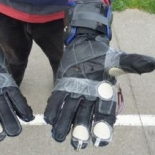Background
As motorbike riders control the majority of a bike's functions with their hands (steering, adjusting the throttle, and using the front brake or clutch), hand dexterity performance is crucial for safe riding. Even minor changes to control inputs can cause a rider to lose control of their bike.
Challenge
To help motorbike riders predict and prevent accidents, Racesafe Australia’s director Mr. Simon Maas and research director, Dr. Greg Harris collaborated with Dr. Daniel Lai and his research team at Victoria University, Australia to create a force-sensing glove system that collects and shares real-time data with riders. This system required unobtrusive force sensors to prevent interference with the rider’s natural movement.
Solution
The team of engineers selected FlexiForce™ sensors for their grip application because of the thinness, flexibility, and lightweight construction of the sensors. In their initial prototype, they applied four FlexiForce A401 force sensors to each glove and interfaced the sensors to a smart phone wirelessly via Bluetooth. The two sensors placed on the index finger and the middle finger monitor two-finger braking activity while the sensors placed on the thumb and the palm record the rotation of the throttle. The system is able to recognize hand activities based on the force feedback from the sensors. The engineers created a novel dynamic calibration method and a series of data classification algorithms to provide accurate hand performance feedback to the rider.
|
This is a diagram of the force feedback system. (1.) Four FlexiForce A401 sensors applied to each glove. (2.) The control box included a chipboard with a MCF51 chip. (3) Bluetooth transceiver used for low power consumption. (4) Data is transmitted to a smartphone or laptop. 1 |
This initial prototype shows the FlexiForce A401 sensors attached to the outside of the gloves. (1) |
The prototype currently allows riders to view their feedback immediately after their ride on their smart phone, which converts, records, and displays the force data. The engineers are very interested in providing active, real-time feedback and plan to explore ways to deliver it without distracting the rider.
The test results of the prototype demonstrate the system’s ability to provide accurate feedback in a natural environment. The engineers have since embedded the sensors into gloves, making the system more durable, and they are currently working on improving their design, with plans to take their product to market. Discover more applications for thin, light, and flexible force sensors on the Tekscan website.
|
This image shows the entire glove system. (1) |
During the prototype testing, the smartphone receiving the force feedback data was mounted on the back of the bike. (1) |
(1) Cai, Zibo; Lai, Daniel T. H; Seyedi, MirHojjat; Ye, Qiang. International Journal of Distributed Sensor Networks. (SAGE Journals, 2015). Force-Sensing Glove System for Measurement of Hand Forces during Motorbike Riding.



